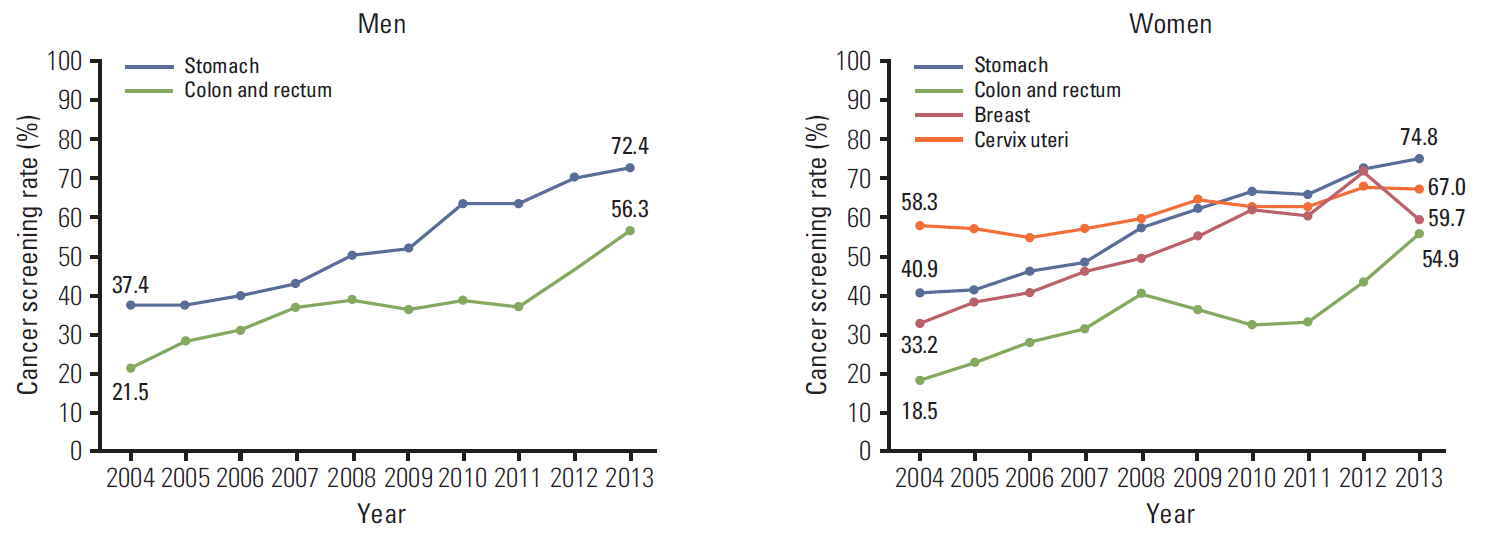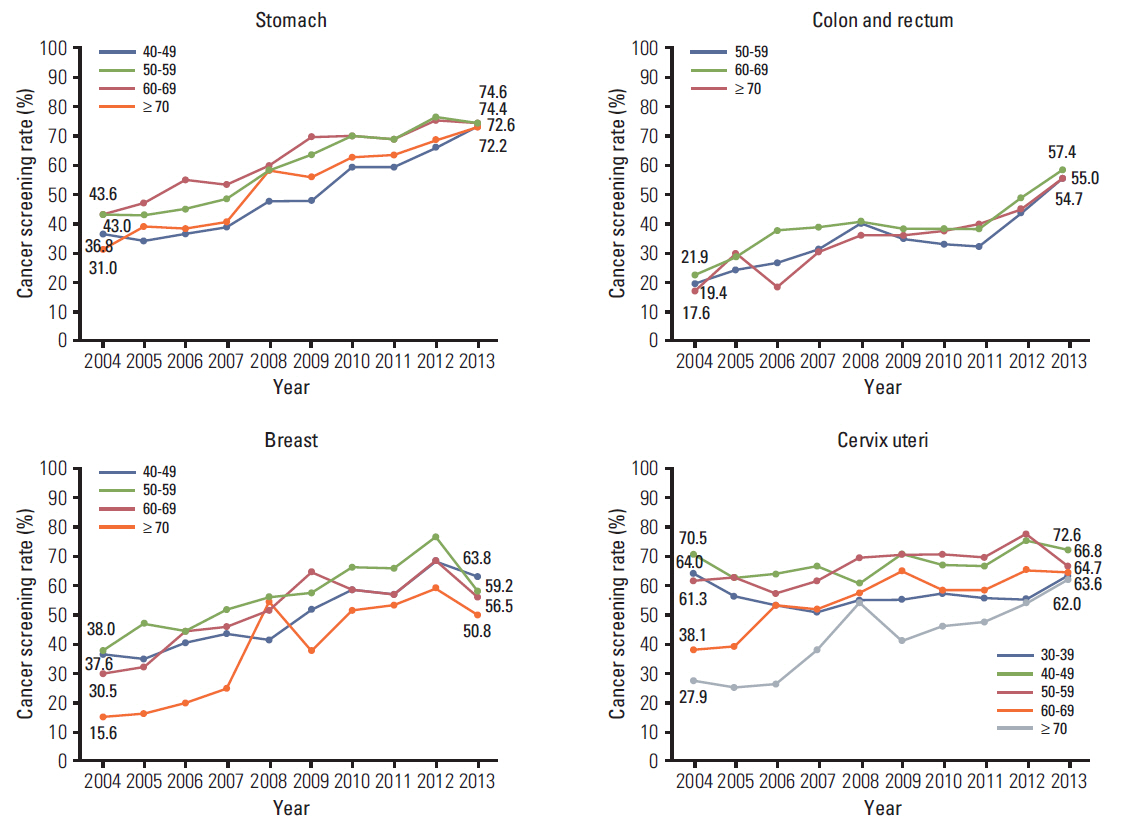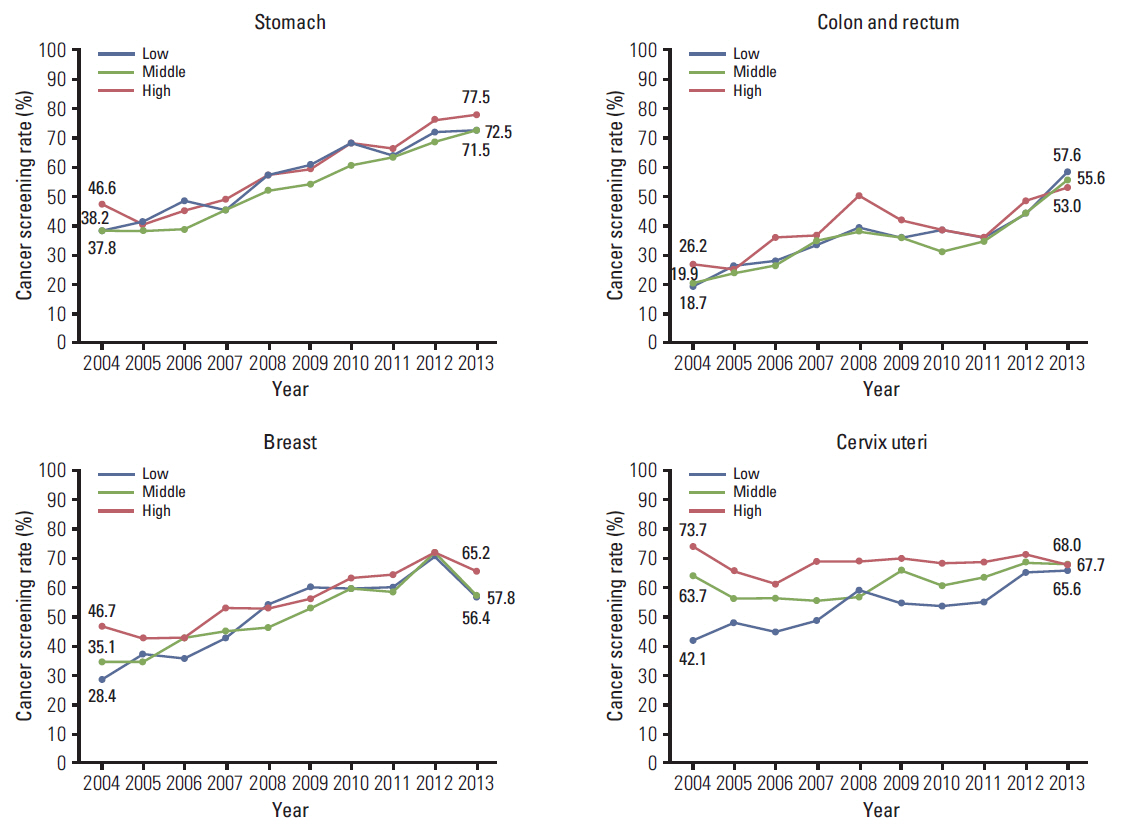Trends in Cancer Screening Rates among Korean Men and Women: Results of the Korean National Cancer Screening Survey, 2004-2013
- Affiliations
-
- 1National Cancer Control Institute, National Cancer Center, Goyang, Korea. drheat@ncc.re.kr
- KMID: 2152254
- DOI: http://doi.org/10.4143/crt.2014.204
Abstract
- PURPOSE
The Korean National Cancer Screening Survey (KNCSS), a nationwide cross-sectional survey, has been conducted annually since 2004. The current study was conducted to report on the trends in screening rates among Korean men and women, and to evaluate policies regarding cancer screening programs implemented to reduce the burden of cancer.
MATERIALS AND METHODS
The current study used KNCSS data. The eligible study population included men aged 40-74 years and women aged 30-74 years with no cancer history. The lifetime screening rate, screening rate with recommendation, and changes in annual rates were calculated for five major cancers (i.e., stomach, liver, colorectal, breast, and cervix uteri).
RESULTS
The screening rates with recommendation increased by 4.2% (95% confidence interval [CI], 3.7% to 4.8%) annually for stomach cancer, 1.2% (95% CI, 0.1% to 2.4%) for liver cancer, 3.0% (95% CI, 1.8% to 4.1%) for colorectal cancer, 3.7% (95% CI, 2.7% to 4.8%) for breast cancer, and 1.3% (95% CI, 0.8% to 1.8%) for cervical cancer. In 2013, the screening rates with recommendation for stomach, liver, colorectal, breast, and cervical cancers were 73.6%, 33.6%, 55.6%, 59.7%, and 67.0%, respectively.
CONCLUSION
Both the lifetime screening rates and screening rates with recommendation for the five above-mentioned cancers increased annually from 2004 to 2013.
MeSH Terms
Figure
Cited by 11 articles
-
Diabetes and Cancer: Cancer Should Be Screened in Routine Diabetes Assessment
Sunghwan Suh, Kwang-Won Kim
Diabetes Metab J. 2019;43(6):733-743. doi: 10.4093/dmj.2019.0177.Analysis of Participant Factors That Affect the Diagnostic Performance of Screening Mammography: A Report of the Alliance for Breast Cancer Screening in Korea
Young Joong Kim, Eun Hye Lee, Jae Kwan Jun, Dong-Rock Shin, Young Mi Park, Hye-Won Kim, Youme Kim, Keum Won Kim, Hyo Soon Lim, Jeong Seon Park, Hye Jung Kim, Hye-Mi Jo,
Korean J Radiol. 2017;18(4):624-631. doi: 10.3348/kjr.2017.18.4.624.Effect of Different Types of Mammography Equipment on Screening Outcomes: A Report by the Alliance for Breast Cancer Screening in Korea
Bo Hwa Choi, Eun Hye Lee, Jae Kwan Jun, Keum Won Kim, Young Mi Park, Hye-Won Kim, You Me Kim, Dong Rock Shin, Hyo Soon Lim, Jeong Seon Park, Hye Jung Kim,
Korean J Radiol. 2019;20(12):1638-1645. doi: 10.3348/kjr.2019.0006.Socioeconomic Inequalities in Cervical and Breast Cancer Screening among Women in Korea, 2005–2015
Eunji Choi, Yoon Young Lee, Mina Suh, Eun Young Lee, Tran Thi Xuan Mai, Moran Ki, Jin-Kyoung Oh, Hyunsoon Cho, Boyoung Park, Jae Kwan Jun, Yeol Kim, Kui Son Choi
Yonsei Med J. 2018;59(9):1026-1033. doi: 10.3349/ymj.2018.59.9.1026.Socioeconomic Inequalities in Stomach Cancer Screening in Korea, 2005–2015: After the Introduction of the National Cancer Screening Program
Eun-young Lee, Yoon Young Lee, Mina Suh, Eunji Choi, Tran Thi Xuan Mai, Hyunsoon Cho, Boyoung Park, Jae Kwan Jun, Yeol Kim, Jin Kyung Oh, Moran Ki, Kui Son Choi
Yonsei Med J. 2018;59(8):923-929. doi: 10.3349/ymj.2018.59.8.923.Why Do Some People Choose Opportunistic Rather Than Organized Cancer Screening? The Korean National Health and Nutrition Examination Survey (KNHANES) 2010-2012
Myung-Il Hahm, Hsueh-Fen Chen, Thaddeus Miller, Liam O’Neill, Hoo-Yeon Lee
Cancer Res Treat. 2017;49(3):727-738. doi: 10.4143/crt.2016.243.Stages of Adoption for Fecal Occult Blood Test and Colonoscopy Tests for Colorectal Cancer Screening in Korea
Nhung Cam Bui, Ha Na Cho, Yoon Young Lee, Mina Suh, Boyoung Park, Jae Kwan Jun, Yeol Kim, Kui Son Choi
Cancer Res Treat. 2018;50(2):416-427. doi: 10.4143/crt.2017.075.Nationwide Trends in the Incidence of Melanoma and Non-melanoma Skin Cancers from 1999 to 2014 in South Korea
Chang-Mo Oh, Hyunsoon Cho, Young-Joo Won, Hyun-Joo Kong, Yun Ho Roh, Ki-Heon Jeong, Kyu-Won Jung
Cancer Res Treat. 2018;50(3):729-737. doi: 10.4143/crt.2017.166.Beliefs and Intentions to Undergo Lung Cancer Screening among Korean Males
Nhung Cam Bui, Yoon Young Lee, Mina Suh, Boyoung Park, Hyunsoon Cho, Yeol Kim, Kui Son Choi
Cancer Res Treat. 2018;50(4):1096-1105. doi: 10.4143/crt.2017.393.Increased Risk of Osteoporosis in Gastric Cancer Survivors Compared to General Population Control: A Study with Representative Korean Population
Su-Min Jeong, Dong Wook Shin, Ji Eun Lee, Sang-Man Jin, Sung Kim
Cancer Res Treat. 2019;51(2):530-537. doi: 10.4143/crt.2018.164.Trends in Cancer Screening Rates among Korean Men and Women: Results of the Korean National Cancer Screening Survey, 2004–2018
Seri Hong, Yun Yeong Lee, Jaeho Lee, Yeol Kim, Kui Son Choi, Jae Kwan Jun, Mina Suh
Cancer Res Treat. 2021;53(2):330-338. doi: 10.4143/crt.2020.263.
Reference
-
References
1. Korea Statistical Information Service [Internet]. Daejeon: Statistics Korea;2014. [cited 2014 Jul 30]. Available from: http://kosis.kr.2. Jung KW, Won YJ, Kong HJ, Oh CM, Lee DH, Lee JS. Cancer statistics in Korea: incidence, mortality, survival, and prevalence in 2011. Cancer Res Treat. 2014; 46:109–23.
Article3. Lee YY, Oh DK, Choi KS, Jung KW, Lee HY, Jun JK. The current status of gastric cancer screening in Korea: report on the National Cancer Screening Programme, 2009. Asian Pac J Cancer Prev. 2011; 12:3495–500.4. Noh DK, Choi KS, Jun JK, Lee HY, Park EC. Factors associated with attending the National Cancer Screening Program for liver cancer in Korea. Asian Pac J Cancer Prev. 2012; 13:731–6.
Article5. Shim JI, Kim Y, Han MA, Lee HY, Choi KS, Jun JK, et al. Results of colorectal cancer screening of the national cancer screening program in Korea, 2008. Cancer Res Treat. 2010; 42:191–8.
Article6. Oh DK, Shim JI, Han M, Kim Y, Lee HY, Jun JK, et al. Breast cancer screening in Korean women: report of the National Cancer Screening Program in 2008. J Breast Cancer. 2010; 13:299–304.
Article7. Lee YH, Choi KS, Lee HY, Jun JK. Current status of the National Cancer Screening Program for cervical cancer in Korea, 2009. J Gynecol Oncol. 2012; 23:16–21.
Article8. Suh M, Choi KS, Lee YY, Park B, Jun JK. Cancer screening in Korea, 2012: results from the Korean National Cancer Screening Survey. Asian Pac J Cancer Prev. 2013; 14:6459–63.
Article9. Lee HY, Park EC, Jun JK, Hahm MI, Jung KW, Kim Y, et al. Trends in socioeconomic disparities in organized and opportunistic gastric cancer screening in Korea (2005-2009). Cancer Epidemiol Biomarkers Prev. 2010; 19:1919–26.
Article10. Sabatino SA, Lawrence B, Elder R, Mercer SL, Wilson KM, DeVinney B, et al. Effectiveness of interventions to increase screening for breast, cervical, and colorectal cancers: nine updated systematic reviews for the guide to community preventive services. Am J Prev Med. 2012; 43:97–118.11. Baron RC, Rimer BK, Coates RJ, Kerner J, Mullen PD, Chattopadhyay S, et al. Methods for conducting systematic reviews of evidence on effectiveness and economic efficiency of interventions to increase screening for breast, cervical, and colorectal cancers. Am J Prev Med. 2008; 35(1 Suppl):S26–33.
Article12. Sano H, Goto R, Hamashima C. What is the most effective strategy for improving the cancer screening rate in Japan? Asian Pac J Cancer Prev. 2014; 15:2607–12.
Article13. NHS Breast Screening Programme: annual review 2012 [Internet]. Sheffield: NHS Breast Screening Programme;2012. [cited 2014 Jul 30]. Available from: http://www.cancerscreening.nhs.uk/breastscreen/publications/nhsbspannualreview2012.pdf.14. Smith RA, Manassaram-Baptiste D, Brooks D, Cokkinides V, Doroshenk M, Saslow D, et al. Cancer screening in the United States, 2014: a review of current American Cancer Society guidelines and current issues in cancer screening. CA Cancer J Clin. 2014; 64:30–51.
Article15. National Cancer Institute. Cancer trends progress report: 2011/2012 update [Internet]. Bethesda, MD: National Cancer Institute;2012. [cited 2014 Jul 30]. Available from: http://progressreport.cancer.gov/sites/default/files/archive/report2011.pdf.16. Yoshida M, Kondo K, Tada T. The relation between the cancer screening rate and the cancer mortality rate in Japan. J Med Invest. 2010; 57:251–9.
Article17. NHS Cervical Screening Programme: annual review 2012 [Internet]. Sheffield: NHS Cancer Screening Programme;2012. [cited 2014 Jul 30]. Available from: http://www.cancerscreening.nhs.uk/cervical/publications/cervical-annual-review-2012.pdf.18. National Cancer Institute. Cancer trends progress report: 2011/2012 update. Cervical cancer screening 2012 [Internet]. Bethesda, MD: National Cancer Institute;2012. [cited 2014 Jul 30]. Available from: http://progressreport.cancer.gov/sites/default/files/archive/report2011.pdf.19. National Cancer Institute. Cancer trends progress report: 2011/2012 update. Colorectal cancer screening 2012 [Internet]. Bethesda, MD: National Cancer Institute;2012. [cited 2014 Jul 30]. Available from: http://progressreport.cancer.gov/sites/default/files/archive/report2011.pdf.20. Caplan LS, McQueen DV, Qualters JR, Leff M, Garrett C, Calonge N. Validity of women's self-reports of cancer screening test utilization in a managed care population. Cancer Epidemiol Biomarkers Prev. 2003; 12(11 Pt 1):1182–7.21. Hoffmeister M, Chang-Claude J, Brenner H. Validity of self-reported endoscopies of the large bowel and implications for estimates of colorectal cancer risk. Am J Epidemiol. 2007; 166:130–6.
Article22. Montano DE, Phillips WR. Cancer screening by primary care physicians: a comparison of rates obtained from physician self-report, patient survey, and chart audit. Am J Public Health. 1995; 85:795–800.
Article23. Ock SM, Choi JY, Cha YS, Lee J, Chun MS, Huh CH, et al. The use of complementary and alternative medicine in a general population in South Korea: results from a national survey in 2006. J Korean Med Sci. 2009; 24:1–6.
Article24. Park B, Lee YK, Cho LY, Go UY, Yang JJ, Ma SH, et al. Estimation of nationwide vaccination coverage and comparison of interview and telephone survey methodology for estimating vaccination status. J Korean Med Sci. 2011; 26:711–9.
Article25. Han MA, Choi KS, Park JH, Moore MA, Park EC. Midcourse evaluation of the second-term 10-year plan for cancer control in Korea. Asian Pac J Cancer Prev. 2011; 12:327–33.
- Full Text Links
- Actions
-
Cited
- CITED
-
- Close
- Share
- Similar articles
-
- Trends in Cancer Screening Rates among Korean Men and Women: Results of the Korean National Cancer Screening Survey, 2004–2018
- Trends in Cancer Screening Rates among Korean Men and Women: Results from the Korean National Cancer Screening Survey (KNCSS), 2004-2011
- Trends in Cancer Screening Rates among Korean Men and Women: Results from the Korean National Cancer Screening Survey (KNCSS), 2004-2010
- Trends in Cancer Screening Rates among Korean Men and Women: Results from the Korean National Cancer Screening Survey, 2004-2012
- Trends in breast cancer screening rates among Korean women: results from the Korean National Cancer Screening Survey, 2005-2020




